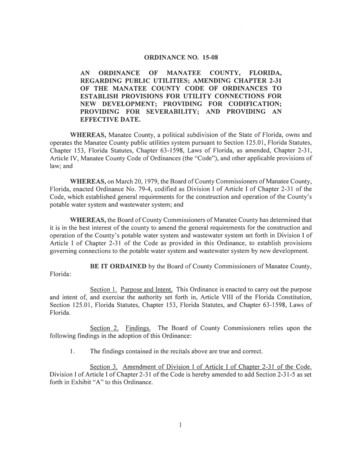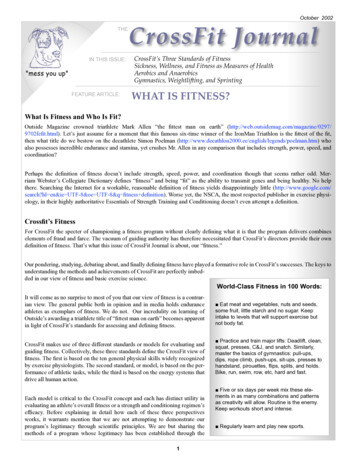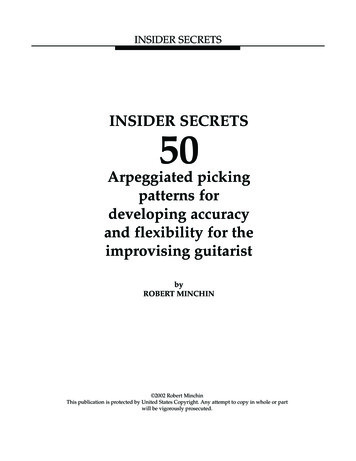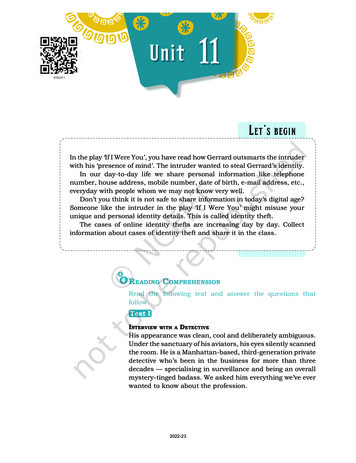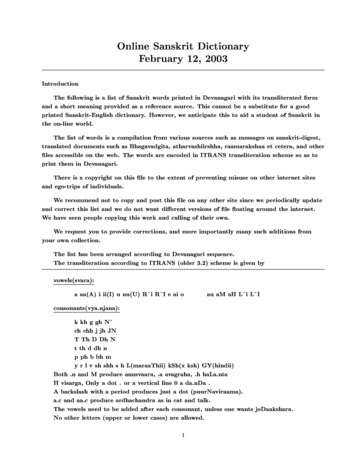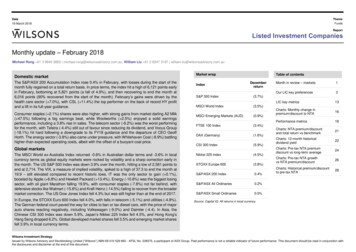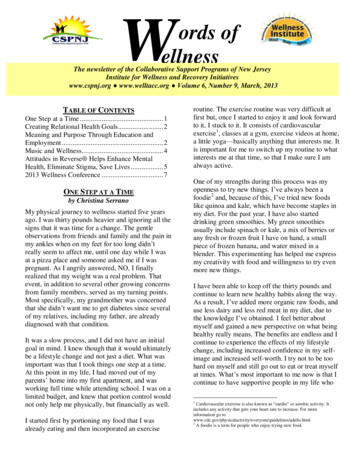
Transcription
Words ofellnessThe newsletter of the Collaborative Support Programs of New JerseyInstitute for Wellness and Recovery Initiativeswww.cspnj.org www.welltacc.org Volume 6, Number 9, March, 2013TABLE OF CONTENTSOne Step at a Time . 1Creating Relational Health Goals. 2Meaning and Purpose Through Education andEmployment . 2Music and Wellness. 4Attitudes in Reverse Helps Enhance MentalHealth, Eliminate Stigma, Save Lives . 52013 Wellness Conference . 7ONE STEP AT A TIMEby Christina SerranoMy physical journey to wellness started five yearsago. I was thirty pounds heavier and ignoring all thesigns that it was time for a change. The gentleobservations from friends and family and the pain inmy ankles when on my feet for too long didn’treally seem to affect me, until one day while I wasat a pizza place and someone asked me if I waspregnant. As I angrily answered, NO, I finallyrealized that my weight was a real problem. Thatevent, in addition to several other growing concernsfrom family members, served as my turning points.Most specifically, my grandmother was concernedthat she didn’t want me to get diabetes since severalof my relatives, including my father, are alreadydiagnosed with that condition.It was a slow process, and I did not have an initialgoal in mind. I knew though that it would ultimatelybe a lifestyle change and not just a diet. What wasimportant was that I took things one step at a time.At this point in my life, I had moved out of myparents’ home into my first apartment, and wasworking full time while attending school. I was on alimited budget, and knew that portion control wouldnot only help me physically, but financially as well.I started first by portioning my food that I wasalready eating and then incorporated an exerciseroutine. The exercise routine was very difficult atfirst but, once I started to enjoy it and look forwardto it, I stuck to it. It consists of cardiovascularexercise1, classes at a gym, exercise videos at home,a little yoga—basically anything that interests me. Itis important for me to switch up my routine to whatinterests me at that time, so that I make sure I amalways active.One of my strengths during this process was myopenness to try new things. I’ve always been afoodie2 and, because of this, I’ve tried new foodslike quinoa and kale, which have become staples inmy diet. For the past year, I have also starteddrinking green smoothies. My green smoothiesusually include spinach or kale, a mix of berries orany fresh or frozen fruit I have on hand, a smallpiece of frozen banana, and water mixed in ablender. This experimenting has helped me expressmy creativity with food and willingness to try evenmore new things.I have been able to keep off the thirty pounds andcontinue to learn new healthy habits along the way.As a result, I’ve added more organic raw foods, anduse less dairy and less red meat in my diet, due tothe knowledge I’ve obtained. I feel better aboutmyself and gained a new perspective on what beinghealthy really means. The benefits are endless and Icontinue to experience the effects of my lifestylechange, including increased confidence in my selfimage and increased self-worth. I try not to be toohard on myself and still go out to eat or treat myselfat times. What’s most important to me now is that Icontinue to have supportive people in my life whoCardiovascular exercise is also known as “cardio” or aerobic activity. Itincludes any activity that gets your heart rate to increase. For moreinformation go /adults.html2A foodie is a term for people who enjoy trying new food.1
Words of WellnessVolume 6, Number 9were with me along my journey and that I live mylife to the fullest in a healthy way. I continue towork toward my balance, and keep remindingmyself to just take things one step at a time.CREATING RELATIONAL HEALTH GOALSMarch, 2013Page 2sensory system too, because I do sensory exerciseswith him to soothe his hypersensitive sensorysystem. I remember the first time we sat in a chairtogether doing one of these, I got a severe headache.I started to think, maybe my sensory system coulduse some exercise.by Carol Coussons de ReyesI have always been a little put off by the term“Chronic Illness Self-Management.” It sounds likea medical model business coach, if you just look atthe words without investigating more. At the sametime, it’s hard to really criticize when we, peoplewith mental illnesses, are dying 25 years earlier. Wehave to act fast to reverse this statistic. So, in 2012 Itook Peer Support Whole Health training offered byAppalachian Consulting. I really like that title! Ilearned so much that I can do to take small steps toimprove my health. As I reflected on the training, Iheard this whole symphony of experiences that mybody has had related to trauma and relationships andwondered how that fit in.I think about relationships often, because I structuretraining for peers in peer support. When I lived inGeorgia, I worked with the Georgia Model of PeerSupport, but it was there also that I learnedIntentional Peer Support by Shery Mead. I have alsomanaged to find healthy relationships, and that wasa long struggle of shuffling through trauma from theage of seven. I was sexually abused by my maternalgrandfather at age seven, and the silence thatfollowed when I asked for help mixed me all upabout expectations in relationships. That experiencecompounded into one abusive relationship afteranother. I was a little less self-destructive intherapy, but that also left me to relying on others tosolve my problems. Finally, peer support came intomy life and that changed everything. From healthypeer relationships, I built more healthy relationshipsbecause, suddenly, I had relationships based onequality. This is a big part of Relational Health.There are sensory skill building exercises too,because our sensory system gets all messed up whenwe experience trauma. Some days, I have to make aconscious thought process for simple things thatinvolve my body, like just getting up from my workbecause I need to go to the bathroom instead ofbeing in pain. My son has taught me a lot about theThe experiences I have with relationships andtrauma all collided in creating Relational Health.It’s still about creating a health goal, but focused onrelationships and trauma. There are so many skillsthat I have amassed over the years that keep megoing, and I draw on them often. Many peopleknow me for my professional work as an Office ofConsumer Affairs Director in Georgia and asDirector of the Behavioral Health Office ofConsumer Affairs in Nebraska, but in this work ofRelational Health I am encountering as a privatecitizen, much like I did in writing a Memoir. So, ifyou would like to learn more about RelationalHealth please contact me atrelationalhealthgoals@gmail.com, and I will be gladto share more.MEANING AND PURPOSE THROUGHEDUCATION AND EMPLOYMENTA little bit of stress, is not always a bad thing, as Jensees it. She explains “My base state is one thatalways has had a little bit of stress. It pushes me tobe the best student and the best employee I can be.”Jen adds that a “little stress goes a long way” andcan “light a fire in her belly, which is a good thing.”She describes that the subsequent stress that cancome from the combination of employment andeducation does not interfere with her recovery. Infact, she says, it has accomplished the opposite,adding that both employment and education havereally been a big source of giving both purpose andmeaning to her life.Jen, who currently works as full-time WellnessCoordinator and Trainer for Collaborative SupportPrograms of New Jersey (CSPNJ), obtained herbachelor’s degree with a dual major in psychologyand psychiatric rehabilitation (PsyR 3) from Kean3PsyR is an abbreviation often used for psychiatric rehabilitationand will be used throughout this article.
Words of WellnessVolume 6, Number 9University and the University of Dentistry andMedicine of New Jersey School of Health RelatedProfessions. Following completion of her bachelor’sdegree, Jen decided to complete a master’s degree inoccupational therapy. She applied to MisericordiaUniversity’s Occupational Therapy master’sprogram, where she was accepted and subsequentlyenrolled. She currently attends weekend classes forthe Occupational Therapy Master’s Degree, alongwith working full-time at CSPNJ.Jen shared that both employment and educationhave always been important value of hers, addingthat both have been instrumental in living awellness-focused lifestyle. She noted that, evenbefore working in the psychiatric rehabilitationfield, she found meaning and purpose in her work atStarbucks. She stated that she met several lifelongfriends there, developed leadership skills, anddeveloped a sense of meaning, purpose, andconfidence.Jen explained that, while she worked at Starbucks,she began going back to school for a degree inPsyR. She explains that the pursuit of her PsyReducation has had a deep impact on her wellness. “Ifelt I’d finally found my niche when I started myPsyR studies,” she said. “I found something I wastruly passionate about. And when you are reallypassionate about something, it gives you a realsense of meaning and a new sense of identity.”Toward the end of her PsyR undergraduateeducation, she began to work in the field. She saysshe still currently works in the field of PsyR; addingthat this is her passion and is a major source offulfillment for her.In regards to the impact of her PsyR work on herown wellness, Jen says this work allows her to giveback, and positively affects many dimensions of herwellness including both emotional and spiritual,through the emotional fulfillment experiencedthrough giving, and acknowledging a sense ofmeaning and purpose through employment.In regards to her graduate education in occupationaltherapy, Jen explains, she is excited to gain a newand broader perspective on health promotion andprevention through her studies, which she hopesMarch, 2013Page 3will allow her to help people experiencing a varietyof challenging or potentially challenging situations.She adds that occupational therapy, “promoteshealth and wellness, prevents disease, and maintainsor improves function, through the use of meaningfuleveryday activities.”The combination of pursing occupational therapyand working full-time has been a positiveexperience for Jen, but she admits it does have itschallenges. She says her social dimension suffersduring the semester as a result of her studies, whichallows little time outside of employment and school.She adds that, although her social dimension isdifficult to maintain, especially during the semester,she sometimes fits time in for socialization and haseven developed new social supports with herclassmates, who are all in similar situations trying tobalance their own wellness. And, betweensemesters, she is able to “make up for lost time” andvisit friends and family; who understand timeduring the semester is limited.Her studies have also impacted her financially, withtravel expenses and overnight hotel stays, but shehas found ways to address this, such as findingroommates and bringing her own food when goingto weekend classes.To deal with the stress of her jam-packed scheduleand maintain wellness, she makes the physicaldimension a priority, focusing on physical activityand sleep and rest. She maintains a workoutprogram six-days-a week at her gym whichaddresses both social and physical dimensions,according to Jen, who says that her gym timeprovides stress relief, and also allows for “a bit ofsocialization.” She adds that she tries to get 8-9hours’ sleep a night too. “If I maintain my sleephabits, I find I am a better student, and a betterworker,” she reveals. She adds that sticking toroutine and being prepared are two additional andvery important stress-reduction tools, explaining sheoften prepares meals and clothes the night before,and tries to go to sleep and wake up at similar timeseach day.
Words of WellnessVolume 6, Number 9Overall, her course of study has also been a verypositive force. She says she is learning a lot and“expanding her intellectual horizons.” Referring toher future, she adds, “I love working with peopleand love making a difference in their lives. Othershave done that for me, and I want to be able to giveback.”She added that, when she earns her occupationaltherapy degree, she hopes to use a combination ofpsychiatric rehabilitation and occupational therapyskills to help promote health, wellness, andindependence in the community.MUSIC AND WELLNESSby Libby Bartholomew and Jay YudofThis article was written by two people. Libby singsand plays a musical instrument. Jay does neither.Both use music as part of their personal wellness.Libby shared, “Music is integral to my life. I sangwith two choirs in High School, including an acappella choir, and then in college, I sang with theDuke University Chapel choir. Singing for Churchis motivating for me; it inspires me. I feel free whenI sing. So, when I got out of the hospital and knew Iwould stay out, I caught a ride to my local church. Iwas asked to join the Bell choir—that’s percussion.I played for 11 years in the bell choir, in addition tosinging with the Adult Worship choir at that church.“After I joined the Bell choir at church, my supportsystem grew to include each of those 8 to 10 fellowchoir members. I am still friends with one of thefamilies. My friend, Carlana gave me a job cleaningher house, which I did for three years while I wasliving mostly on Social Security DisabilityInsurance; and, whenever I had a problem where Ineeded to talk, she was always there for me. Iconsidered my joining the Bell choir an importantpiece in helping me to recover. Having to countthrough each of the notes in my head as we wererehearsing helped me to move away from dwellingon the intrusive thoughts that were going on that Icouldn’t seem to stop. I realized that I had controlover my thinking and could think thoughts that Iwanted to think. I didn’t have to allow myself to beconsumed by all the garbage about mental healthand what I had gone through in my pastMarch, 2013Page 4hospitalizations that seemed to be going through myhead.“Over the years, I have developed a sense ofperformance skills, and I love to sing for largeaudiences or congregations. Both my sister andbrother invited me to sing at their recent weddings.It was the thrill of my life. And people came up tome in astonishment afterward, that I could sing likethat.”Jay introduces his reply with the lyrics to a favoritesong:An automatic alarm, Turns my radio onBefore my feet can hit the floor, The music'sgot me ready to goAnd all through the whole day, I know myfavorite records they'll playIt helps me chase all my blues away 4“I am one of the millions of people who uses musicto manage my moods and help and accompany methrough my daily activates. Like many people, Ichoose different kinds of music to listen to, basedon how I feel, and how I want to feel. I can choosevarious kinds of music to help me wake up, to helpme relax, or to shut out sounds around me when Ineed to concentrate.“Music surely affects my moods and thoughts, andbrings back memories. When I listen to the music ofmy faith, I cannot help but think of my late mother,who got a lot of comfort from religious music.When I listen to classical music, I think of my latefather, who preferred classical, and introduced me tothe genre. When I hear a recording of John Lennonor Karen Carpenter or Edwin Starr (who wrote andreleased the H.A.P.P.Y. Radio song partiallytranscribed above) or any of the dozens of othermusic writers and performers who died early in theircareers, a tear comes to my eye. My wife and I arehappily married for over thirty years, and the songwe first danced to at our wedding, Endless Love,brings up powerful emotions. I know many otherpeople who are so moved by the songs they dancedto at their weddings and sang and taught to theirchildren.4Lyrics from H.A.P.P.Y. Radio, 1973, Edwin Starr.
Words of WellnessVolume 6, Number 9“The more I talk to people, the more I realize thatmusic is one of the ways we are all both differentand similar at the same time. I talk to people whosing in choirs or perform in bands or pluck atguitars, and derive some comfort and relaxationfrom making music. Some of these music makersbenefit from developing a sense of capability andmastery via their musical talents. I talk to peoplewho carefully choose the music to power theirworkouts. I talk to people who use music as a saferoute to an alternate state of reality5.”We both hope that music can be as helpful to you asit has beenATTITUDES IN REVERSE HELPS ENHANCEMENTAL HEALTH, ELIMINATE STIGMA,SAVE LIVES“Mental illness is like air. Just because you don’tsee it, it doesn’t mean it isn’t there. It is all aroundus.”Katelyn Baker said this in 2009, soon after losingher 19-year-old brother Kenny to suicide anddealing with discrimination and hurtful commentsabout the suicide. Her “air” concept led to thecreation of Attitudes in Reverse (AIR) and earnedKatelyn, 16 years old at the time, an AmbassadorAward from the Governor’s Council on MentalHealth Stigma in 2011.“We met a lot of discrimination due to Kenny’sdeath. That’s why we’re doing this,” said TriciaBaker, Katelyn’s mother and co-founder of AIR.Another motive is to help prevent for others thedifficulties the Bakers faced in seeking services forKenny prior to his first suicide attempt.Reversing Attitudes through SchoolPresentationsTricia and her husband, Kurt, give presentations atschools and, when allowed by the schooladministration, bring their Certified Therapy DogMiki along with them. The first presentation wasdelivered in 2011 and, as of the end of January5Such as putting on Pink Floyd at the end of a day and gettingComfortably Numb.March, 2013Page 52013, the Bakers have spoken to 9,000 middle andhigh school students in New Jersey. “We’rebecoming popular because of the quality of ourpresentation. Teachers know the students need tohear the information, but most teachers don't knowthe right way to teach the subject and many areuncomfortable teaching it because of stigma,” Kurtsaid.Several more presentations in the state are planned,as well as out-of-state presentations at colleges inNew York and Vermont. In addition, AIR willexpand into Georgia, where Karen Griffin Jolley, aFacebook friend of Tricia’s for more than threeyears now, plans to give AIR presentations and, infact, has already shared AIR’s message with herstudents at Central Georgia Tech.Kurt begins each presentation dynamically sharingthe essential facts about mental illness and suicide,and he engages the students with details they canrelate to: famous performers who had or havemental illness, and the distinctions between mentalillness and the stress and difficult emotions thatteens commonly experience. Kurt also explains andreinforces the importance of healthy habits thatfoster strong mental health. Then, Tricia delivers avery touching presentation of Kenny's story: thecontrast between her son's dynamic personality andseemingly full life, with his long struggle withsevere clinical depression and anxiety that wasended almost four years ago when he completedsuicide. “When I talk about Kenny, you could hear apin drop,” Tricia said. “We want to get kids tounderstand it’s not just kids who appear depressedwho could be at risk of attempting suicide. Somepeople are very good at hiding their depression andsuicidal thoughts.”The students also learn about resources, such asstate and national hotlines, and are encouraged tospeak with trusted adults when they or their friendsneed help. They are also invited to share theirstories during the presentation. “We have severalstudents who have mental illness or recovered fromaddictions who travel with us and share theirpersonal journeys. These young people want to helpothers,” Tricia added.
Words of WellnessVolume 6, Number 9Expanding their Mission with AIR Dogs: Pawsfor Minds “When we exhibit at community events, peoplecome to us to pet Miki and ask questions about AIR,and it leads to conversations about mental illnessand suicide. Many have opened up about thesestruggles in their families,” Kurt said.“Many people have said their dogs saved their livesand others said they are lonely and want dogs. Fromthese conversations, the idea for AIR Dogs cameabout,” Tricia said.“We realized how much it helps people and it wouldcertainly help dogs. It saves two lives,” Kurt added,referring to dogs at shelters who show potential ofbecoming Emotional Support Dogs. A certaintemperament and specific skills are needed, and thecandidates are trained by Adrienne Carson, a dogtrainer and behavioral consultant, as well as“recruiter” of potential AIR Dogs at two shelterswhere she works.Initiating Relationships that Yield Many BenefitsTricia explained the physiological reason whypetting dogs is good for people. “It releasesserotonin, oxytocin and dopamine – all good brainchemicals,” she said. The proof is clear whenspeaking with Stacey and Matthew, recipients of thefirst two AIR Dogs.In just the first few months of having Oliver, Staceygained tremendous benefits. “I get up at the sametime every day and no naps are allowed. That’s beena positive thing for me,” she said. “I’ve been verylonely. Now, people come up to me and askquestions. Oliver brings out the best in me.”Oliver has transformed life for Stacey’s parents, aswell. “When Oliver came into our lives, myhusband thought a dog would be too much work forStacey, but she proved her father wrong,” saidStacey’s mother, Georgia. Naturally, the entirefamily is enjoying Oliver, as well as participating inAIR events together.Roxie proved to be an ideal Emotional Support Dogfor 10-year-old Matthew, who has anxiety,depression, and a pervasive developmental disorder.He and his mother, Lauren, learned about theMarch, 2013Page 6program at the first annual Miki & Friends: Walk &Run for AIR in May 2012. “Roxie is not a crutch;she’s more than that. Even when Roxie’s notaround, Matthew can talk about her,” Lauren said.“Here’s an excellent opportunity to utilize dogs inthe community. People can use them in supportivehousing. It really helps; it gives people something tofocus on other than themselves,” she added.Stacey, Matthew, and their dogs attend weeklytraining classes, as well as AIR events. “It’s great.Matthew usually doesn’t want to go out, but he’ll dowhatever Roxie is involved in,” Lauren said. Tomake the training more fun for Matthew, Tricia gota skateboard for Roxie, who is starting to get thehang of it.Building Awareness, Seeking Volunteers andOther SupportFor more information, visitwww.attitudesinreverse.org. Also, click on theEvents tab for details and registration forms for Miki& Friends: Walk & Run for AIR, which will be heldin Mercer County Park’s East Picnic Area on May18, 2013. This event, which is being supported bythe national chain of Petsmart stores and severallocal businesses, will feature much more than thewalk and 5K run. “We are going to do a butterflyrelease to remember all those who we lost too early.We will also put on a concert; a Blessing of theAnimals; and a Mini-Meet the Breeds presentation;Bright & Beautiful Therapy Dog Testing; and AKCCanine Good Citizen Testing,” Tricia said.Karen will participate in the event to finally meetthe Bakers in person and to continue her support forAIR. “I have so much respect for what they’vedone. It’s amazing. I believe this program will benationwide one day. It’s so important. I knowthey’ve helped so many people to feel less alone,”Karen said.In fact, Karen is so impressed with and connected toAIR that she has launched the Climbing Kili for AIRcampaign with coworker Kenneth Rollins to buildawareness of AIR and mental illness. Karen andKenneth launched a fundraising initiative and willdo a media blitz in May, right before Karen comesto New Jersey for the Walk & Run event.Throughout the following months, they will
Words of WellnessVolume 6, Number 9continue media outreach and fundraising efforts.Their campaign will reach its summit – literally –with Karen’s climb of Mount Kilimanjaro inDecember.“On days when I’m dragging, I think about all theBakers are doing and I tell myself, ‘Get up and getmoving,’” Karen said. “They do so much. It’s got tobe so tiring and they keep going,”And they certainly do! In addition to their schoolpresentations, which are filling up their calendarsquickly, planning the Walk & Run event andseeking potential AIR Dogs, the Bakers are alsorunning an annual T-shirt design contest. See detailsin the Events section of the AIR website,www.attitduesinreverse.org. Entries are dueFebruary 28, 2013 and the winner will beannounced at the Walk & Run event.The Bakers are also actively recruiting volunteers tohelp achieve their vital mission. “We are 100percent volunteer and we are passionate. I think wehave accomplished much in a fairly short period oftime. There is so much more we want to do, wehave lots of plans and we hope to get morevolunteers to help us carry them out,” Tricia said.Information on everything about AIR can also beobtained by contacting Tricia attricia@AttitudesInReverse.org; 609-945-3200, ext.1124; or Attitudes in Reverse, P.O. Box 3127,Princeton, NJ 08543.2013 WELLNESS CONFERENCEWe have confirmed the workshop schedule for ourannual Wellness Conference. We hope you will joinus on March 22, 2013 at the Pines Manor in Edison,NJ. A registration form is online atwww.welltacc.org.WELCOME, PANEL AND INVITED PRESENTERSWelcome from the Commissioner of the NJDepartment of Human Services - JenniferVelezA Candle in the Dark: My Journey fromAdversity to Advocacy - Gayathri RamprasadWellness Coaching Works! - Anthony Jones,Joseph Meany, Joseph Repasky, & PeggySwarbrickMarch, 2013Page 7The Latest on SAMHSA’s Wellness Initiative- Lauren SpiroAM WORKSHOPSDual Recovery Self-Help Groups: Options,Techniques, Challenges & Promised Benefits Ed Madara and two Co-presenters, who are dualrecovery group leaders. Panelists will discuss thetypes of dual recovery support groups available,their formats, and the availability, advantages, anddisadvantages of each. They will also discusstechniques for starting and maintaining the groups,while sharing research and personal testimony asto how groups meet members’ needs for recovery.Participants will brainstorm the challenges oflearning a 12-step approach, nurturing long-termgroup leadership, and dealing with imposedprofessional presence at, and supervision of, 12step dual recovery group meetings at agencies.Creating Health Homes in Behavioral HealthSettings: Successes, Challenges, and PlannedNext Steps - James Schuster, Susan O’Toole, andPeer Wellness Coaches. Many counties andproviders throughout Pennsylvania have createdinnovative models that allow behavioral healthsettings to identify and coordinate services thatsupport individuals’ physical health and wellnessgoals as well as their behavioral health needs. Thispresentation will discuss key elements of suchmodels including implementation strategies,implementation of wellness coaching, the role ofnurses located in behavioral health settings whoare focused on physical health concerns, the roleof wellness coaches, and identification of keyphysical health prevention and treatment needs ina variety of provider settings. Strategies forassessing the impact will also be reviewed.Managing Your Time Effectively To CreateAnd Sustain Wellness And Recovery - SuzanneWhite. This workshop will explore how timemanagement strategies can help you create andsustain a wellness lifestyle. This session willinclude experiential exercise; you will learn aboutyour personal time clock, and discover practicaltools for effective time management. Participantswill design a personal organization and timemanagement strategy that can help build moremanageable lifestyles.
Words of WellnessVolume 6, Number 9Hearing Voices Network - Lois Miller andMelissa McLean. Many people experience hearingvoices and do not have symptoms that would leadto a diagnosis. The experience of hearing voices isoften related to life history.Family Wellness and Recovery - Tom Pyle.When we talk about “wellness,” we usually thinkabout the wellness of consumers in recovery.What about their families? The presenter willshare a framework for addressing the wellness andrecovery of family members.Leisure and Recreation to SupportSocial/Emotional Health - Gretchen Snethen andGena Vargas. During this session, we will provideinformation about the social and emotionalbenefits of leisure participation. The majority ofthe session will be a hands-on session to developan individualized plan that identifies strategies forengagement in interest-based leisure activities thatwill support social wellness. Included in the plandevelopment is how to evaluate individualexperiences, which is essential to promoting futureparticipation. Participants will leave the sessionwith an individualized plan, along with worksheetsto help evaluate and sustain participation.Ayurveda: The Everyday Approach to Yogaand WRAP - Linda Meyer and Meg Stenson.WRAP (Wellness Recovery Action Plan),developed by Mary Ellen Copeland, is tool tohelp people who are dealing with emotional orphysical challenges. Ayurveda is the science oflife and Yoga utilizes its principles to combinewith WRAP for a fully modern approach towellness.PM WORKSHOPSCultivating Wellness: Holistic Practices toPromote Mental Health and Wellness Gayathri Ramprasad. Wellness incorporatesmany dimensions of health: physical, emotional,financial, social, occupational, intellectual,environmental, and spiritual. The presenter willhelp participants examine the healing power ofdeep bre
occupational therapy. She applied to Misericordia University's Occupational Therapy master's program, where she was accepted and subsequently enrolled. She currently attends weekend classes for the Occupational Therapy Master's Degree, along with working full-time at CSPNJ. Jen shared that both employment and education
